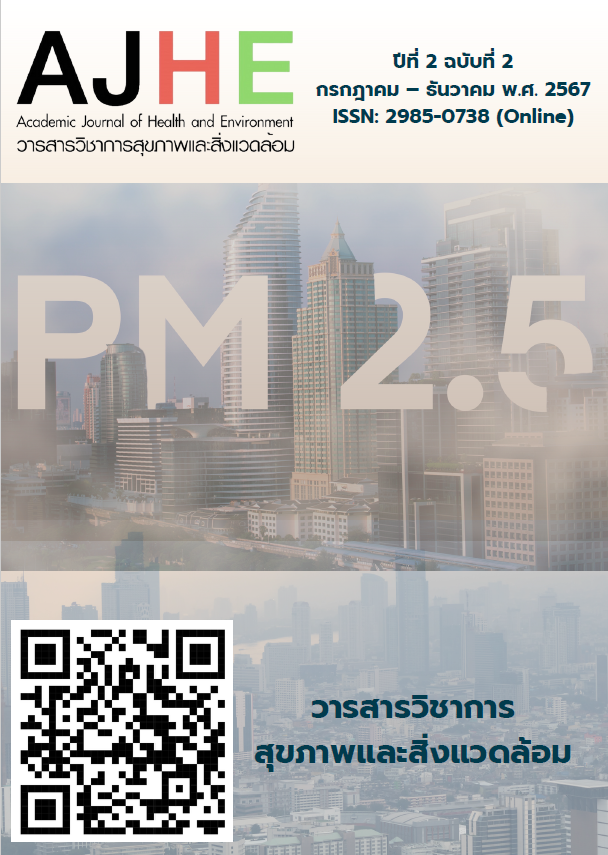การประเมินผลการบริบาลเภสัชกรรมต่อการควบคุมระดับน้ำตาลในเลือดของผู้ป่วยเบาหวานชนิดที่ 2 ในโรงพยาบาลอากาศอำนวย
Evaluation of Pharmaceutical Care on Glycemic Control in Type 2 Diabetic Patients at Akat Amnuai Hospital
DOI:
https://doi.org/10.55674/ajhe.v2i2.3430Keywords:
การบริบาลเภสัชกรรม , โรคเบาหวานชนิดที่ 2, การควบคุมระดับน้ำตาลในเลือดAbstract
การวิจัยนี้เป็นวิจัยกึ่งทดลองมีวัตถุประสงค์เพื่อประเมินประสิทธิผลของการบริบาลเภสัชกรรมในผู้ป่วยโรคเบาหวานชนิดที่ 2 ในโรงพยาบาลอากาศอำนวย โดยใช้ค่าตัวชี้วัด HbA1c เป็นตัวชี้วัดหลักในการประเมินการควบคุมระดับน้ำตาลในเลือด และผลลัพธ์ทางคลินิก ได้แก่ ความดันโลหิต ระดับไขมันในเลือด และการทำงานของไต กลุ่มตัวอย่างคัดเลือกจากคลินิกผู้ป่วยนอกเป็นผู้ที่มีระดับ HbA1c มากกว่า 8 mg% ต่อเนื่องเป็นเวลา 2 ครั้ง ภายใน 1 ปี วิธีดำเนินการวิจัยโดยการเปรียบเทียบผลลัพธ์ทางคลินิกก่อนและหลังการให้บริการบริบาลเภสัชกรรม โดยเภสัชกรมีหน้าที่ให้ความรู้เรื่องโรค ความรู้เรื่องยา ให้คำปรึกษาเรื่องยา ประเมินปัญหาเกี่ยวกับยาของผู้ป่วย และแนะนำการปฏิบัติตัวต่อตัวโรคเบาหวานชนิดที่ 2 โดยมีการบันทึกผลเลือด ความดันโลหิต และค่าการทำงานของไต ติดตามผลเป็นเวลา 6 เดือน เริ่มตั้งแต่มกราคม ถึง มิถุนายน พ.ศ. 2567 วิเคราะห์ข้อมูลโดยใช้สถิติเชิงพรรณนา และเปรียบเทียบความแตกต่างโดยสถิติ paired t-test และ independent t-test
ผลการวิจัยพบว่า ผู้ป่วยที่ได้รับการบริบาลเภสัชกรรมสามารถควบคุมระดับน้ำตาลในเลือดได้มากกว่าก่อนการทดลองอย่างมีนัยสำคัญทางสถิติ (p<0.05) จากการศึกษานี้พบว่าการให้บริบาลเภสัชกรรมมีบทบาทสำคัญในการเพิ่มประสิทธิผลทางคลินิกและส่งเสริมการดูแลตนเองของผู้ป่วยเบาหวาน
References
(1) สมาคมโรคเบาหวานแห่งประเทศไทย. รายงานประจำปีสถานการณ์โรคเบาหวานในประเทศไทย. 2564.
(2) American Diabetes Association. Standards of medical care in diabetes-2019.
Diabetes Care. 2019;42(Supplement 1) https://doi.org/10.2337/dc19-S001
(3) Stratton IM, Adler AI, Neil HA, Matthews DR, Manley SE, Cull CA, et al. Association
of glycaemia with macrovascular and microvascular complications of type 2
diabetes (UKPDS 35): prospective observational study. BMJ. 2000; 321(7258): 405-12.
https://doi.org/10.1136/bmj.321.7258.405
(4) Choe HM, Mitrovich S, Dubay D, Hayward RA, Krein SL, Vijan S. Proactive case
management of high-risk patients with type 2 diabetes mellitus by a clinical
pharmacist: A randomized controlled trial. Am J Manag Care. 2005; 11(4): 253-60.
(5) Simpson SH, Majumdar SR, Tsuyuki RT, Lewanczuk RZ, Spooner R, Johnson JA.
Effect of adding pharmacists to primary care teams on blood pressure control in
patients with type 2 diabetes: A randomized controlled trial. Diabetes Care.
; 27(12): 2983-9.
(6) Jameson JP, Baty PJ. Pharmacist collaborative management of poorly controlled
diabetes mellitus: A randomized controlled trial. Am J Manag Care.
; 16(4): 250-5.
(7) UK Prospective Diabetes Study (UKPDS) Group. Intensive blood-glucose control
with sulphonylureas or insulin compared with conventional treatment and risk of
complications in patients with type 2 diabetes (UKPDS 33). Lancet.
; 352(9131): 837-53. https://doi.org/10.1016/S0140-6736(98)07019-6
(8) Mahfouz M, Awadalla H. Compliance to diabetes self-management in rural El-
Minia, Egypt. Cent Eur J Public Health. 2011; 19(1): 35-41.
(9) จุฑารัตน์ ศิริวัฒนานนท์ และคณะ. ผลการบริบาลเภสัชกรรมในผู้ป่วยเบาหวานชนิดที่ 2
ในโรงพยาบาลชุมชน. 2018.
(10) Choe, H. M., Mitrovich, S., Dubay, D., Hayward, R. A., Krein, S. L., & Vijan, S. (2005).
Proactive case management of high-risk patients with type 2 diabetes mellitus by
a clinical pharmacist: A randomized controlled trial. American Journal of
Managed Care, 11(4), 253-260.
(11) Collins, C., Laskaratos, F. M., & Ates, F. (2011). The effectiveness of multifaceted
pharmacist interventions on glycemic control in type 2 diabetic patients: A
systematic review and meta-analysis of randomized controlled trials. Journal of
Clinical Pharmacy and Therapeutics, 36(2), 244-252.
https://doi.org/10.1111/j.1365-2710.2010.01183.x
(12) Barry L. Carter, PharmD; Gail Ardery, PhD; Jeffrey D. Dawson, ScD; et al. (2009).
Physician and Pharmacist Collaboration to Improve Blood Pressure Control. Arch
Intern Med. 2009; 169(21): 1996-2002. doi:10.1001/archinternmed.2009.358
(13) Weissman, E. M. (2002). Effectiveness of pharmacist interventions to improve
clinical outcomes in patients with Type 2 diabetes mellitus: A systematic review
and meta-analysis. The Diabetes Educator, 28(3), 417-428.
(14) Kahn, S. E., Haffner, S. M., & Heise, M. A., for the ADOPT Study Group. (2006).
Glycemic durability of rosiglitazone, metformin, or glyburide monotherapy. New
England Journal of Medicine, 355(23), 2427-2443.







